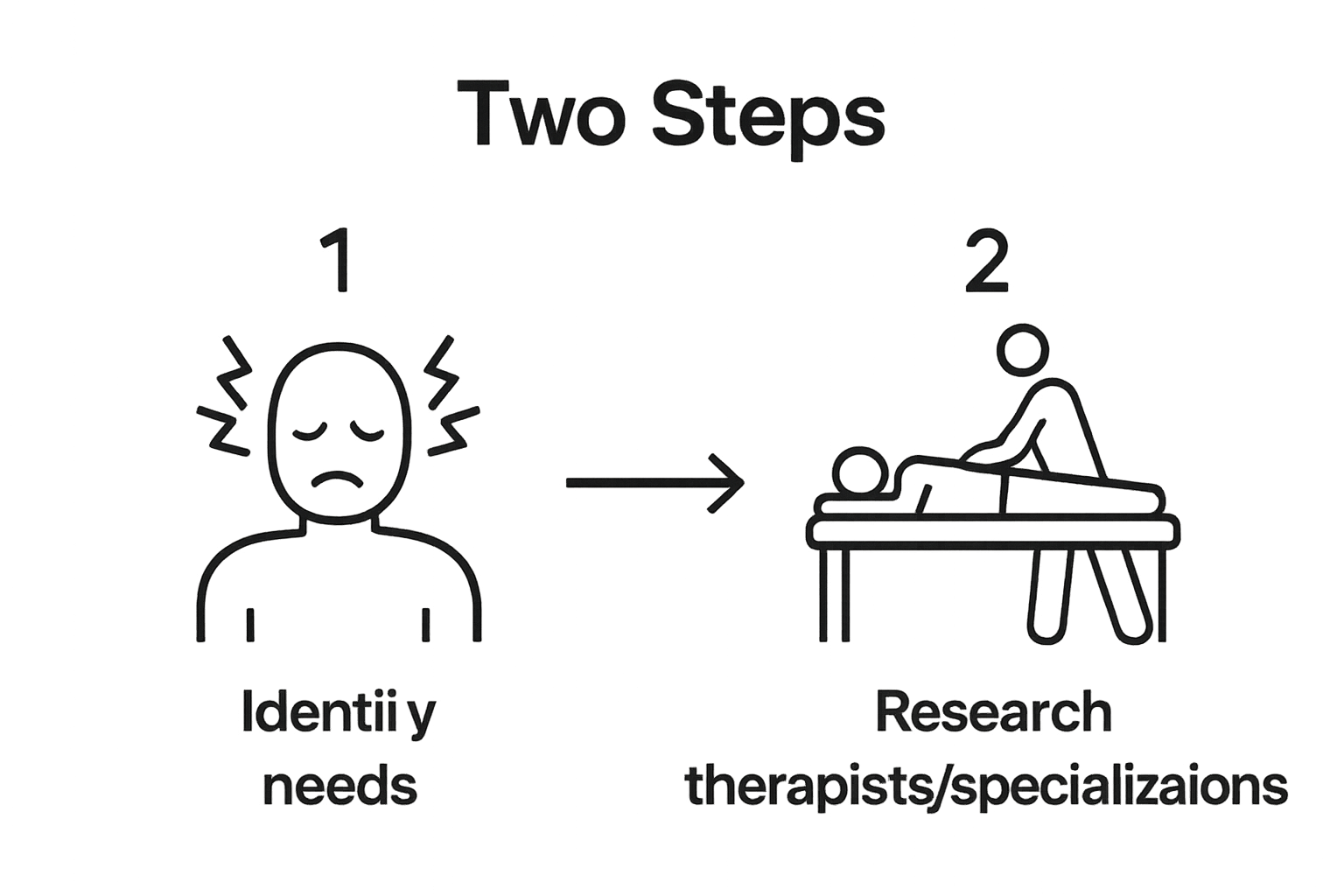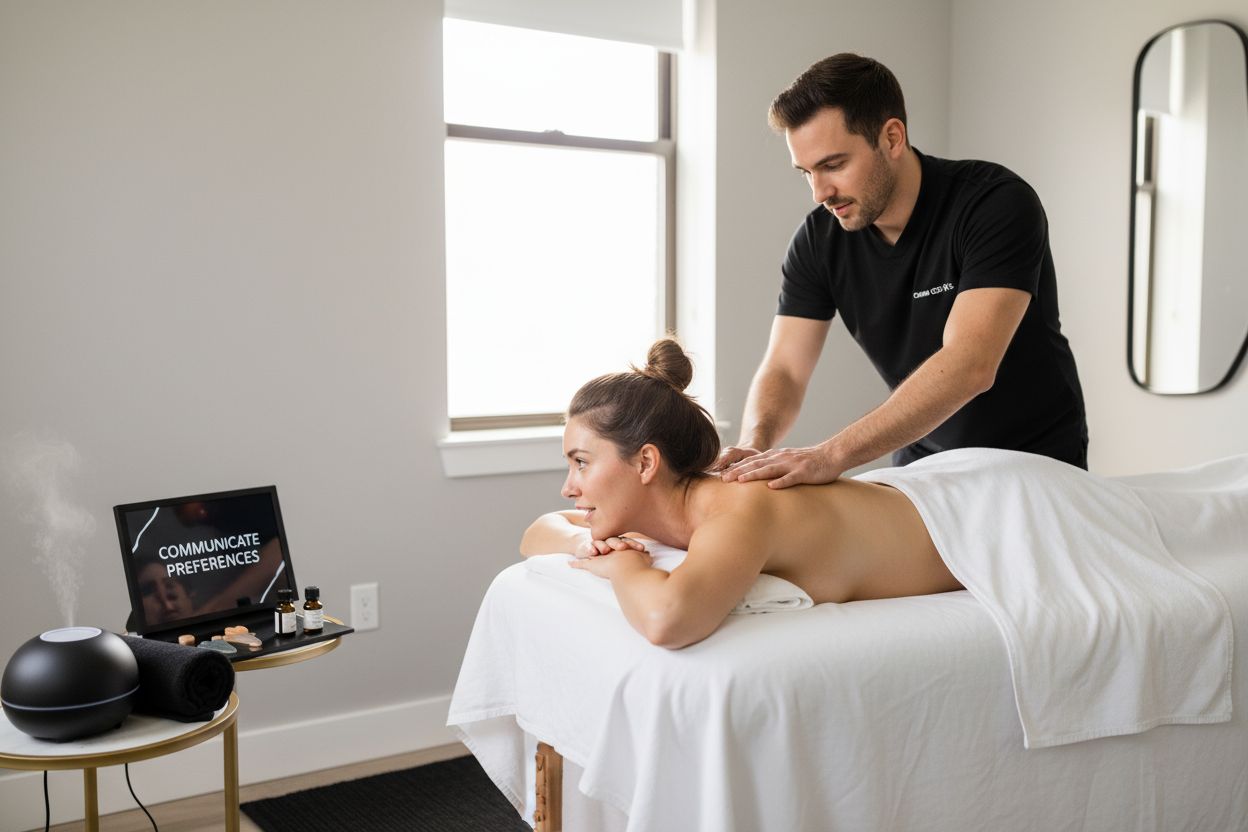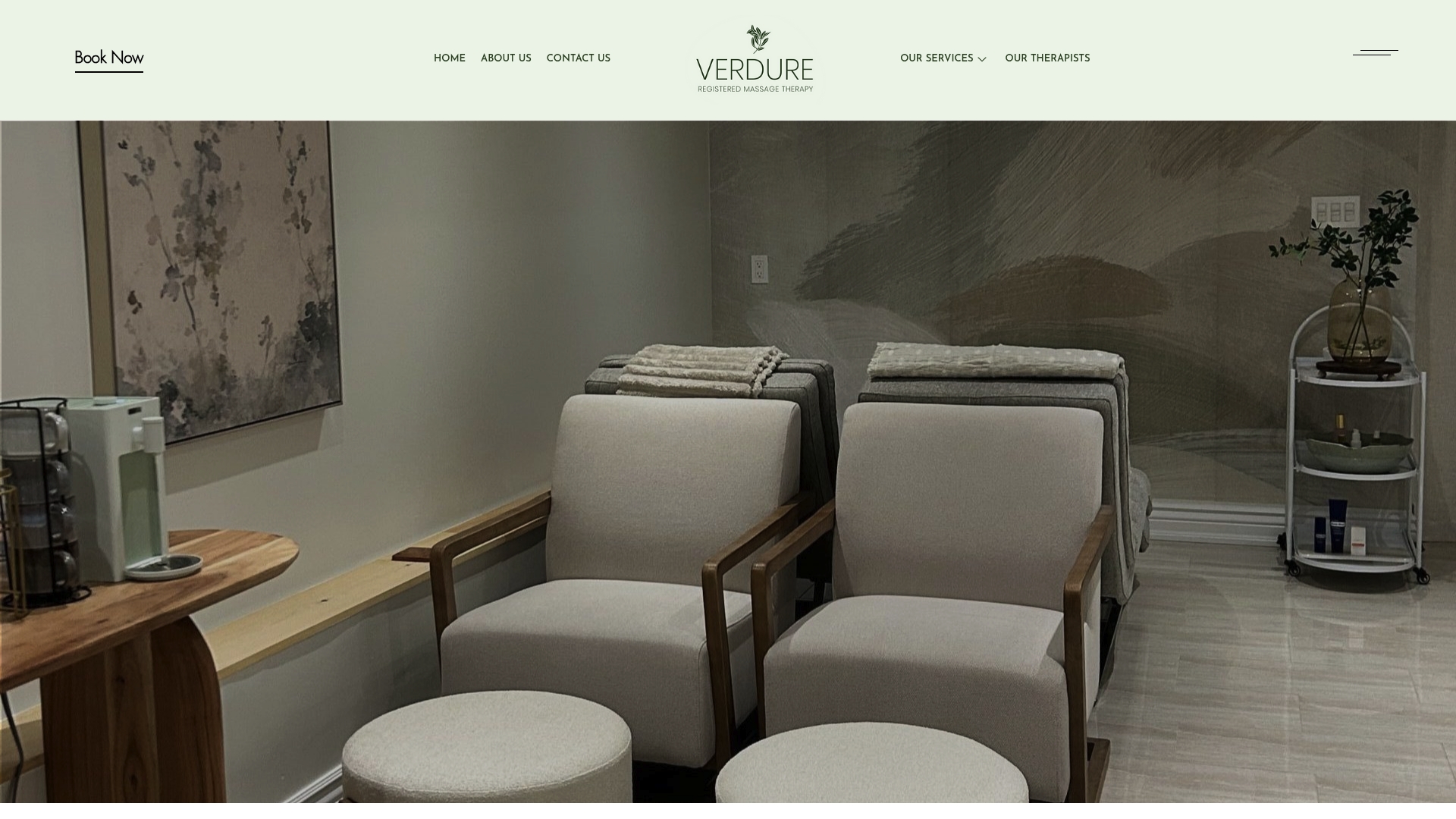Finding the right massage therapist is more than just picking a name from a list. Over 50 percent of massage clients report better results when their treatment plans are tailored to their personal needs. Most people think any massage will do the trick, that one session fits all. Reality check. A truly effective massage experience starts long before you lie down on the table and it hinges on a few surprising steps almost everyone skips.
Table of Contents
- Step 1: Identify Your Unique Needs And Goals
- Step 2: Research Local Massage Therapists And Specializations
- Step 3: Schedule A Consultation For Customized Assessment
- Step 4: Communicate Your Preferences During The Session
- Step 5: Reflect On The Experience And Adjust As Needed
Quick Summary
| Key Point | Explanation |
|---|---|
| 1. Identify Your Unique Needs | Reflect on your physical and mental health to define specific wellness goals before seeking massage therapy. |
| 2. Research Specialized Therapists | Look for registered therapists with credentials and specializations that align with your wellness objectives for personalized treatment. |
| 3. Schedule a Comprehensive Consultation | Prepare detailed health information and expect a thorough assessment to create a tailored massage therapy plan. |
| 4. Communicate Preferences During Sessions | Share your comfort levels and feedback with the therapist to ensure a customized and effective massage experience. |
| 5. Reflect on Each Massage Experience | Document your physical and emotional responses after each session to help adjust future treatments effectively. |
Step 1: Identify Your Unique Needs and Goals
Personalized massage therapy begins with a critical first step: understanding your body’s specific requirements and wellness objectives. This foundational stage transforms a generic massage experience into a targeted healing journey tailored precisely to your individual needs.
Every individual’s body tells a unique story of tension, stress, and physical challenges. Before scheduling your first massage, take time for honest self-reflection about what you hope to achieve. Are you experiencing chronic lower back pain from long office hours? Do you feel overwhelmed by work-related stress? Are you recovering from an athletic injury or managing postural misalignments?
Physical Assessment Strategies
Start by conducting a thorough personal inventory of your physical and mental state. Track areas of consistent discomfort, note your stress levels, and consider your lifestyle patterns. For desk workers, this might mean recognizing recurring neck and shoulder tension. For athletes, it could involve identifying muscle groups requiring specialized recovery techniques.
Consider documenting your observations systematically. Some effective documentation strategies include:
- Tracking pain locations and intensity over one week
- Recording sleep quality and energy levels
- Noting physical activities and corresponding bodily responses
These detailed insights will help your registered massage therapist design a precise treatment plan that addresses your specific wellness goals. A professional therapist will use this information to select appropriate massage modalities, pressure levels, and therapeutic techniques.
According to Mayo Clinic research, understanding your body’s unique needs significantly enhances massage therapy’s effectiveness. By approaching your first session with clarity and self-awareness, you’re already taking a crucial step toward holistic healing and personalized wellness.
Remember, communication is key. During your initial consultation, be prepared to share your documented observations, discuss your health history, and articulate your specific wellness objectives. This transparency enables your massage therapist to craft a truly personalized treatment strategy that resonates with your body’s individual requirements.
Step 2: Research Local Massage Therapists and Specializations
After identifying your personal wellness needs, the next crucial step is finding a massage therapist whose expertise precisely matches your requirements. This research phase transforms your healing journey from a generic experience to a targeted, personalized therapeutic intervention.
Begin by exploring registered massage therapists who specialize in the specific modalities that align with your identified needs. Professional credentials matter significantly in this selection process. Look for therapists registered with recognized professional bodies, which ensure they have completed rigorous training and maintain high standards of practice.
Comprehensive Research Strategies
Utilize multiple research channels to gather comprehensive information about potential massage therapists. Online platforms like professional association websites, detailed clinic profiles, and verified review platforms provide invaluable insights. Pay close attention to therapists’ background, specialization areas, and client testimonials that reflect experience with conditions similar to yours.
During your research, prioritize therapists who demonstrate:
- Advanced certifications in specific massage techniques
- Experience treating conditions matching your health goals
- Clear communication about their therapeutic approach
- Proven track record of successful client outcomes
According to National Institutes of Health research, thorough therapist background verification is essential for ensuring safe and effective massage therapy. Take time to review potential therapists’ professional qualifications and areas of specialized expertise.
Consider scheduling initial consultation calls or brief meetings to discuss your specific needs. Many professional clinics, like our therapists at Verdure, offer preliminary consultations that allow you to assess compatibility and discuss potential treatment strategies. These conversations provide an excellent opportunity to ask detailed questions about their approach, techniques, and how they might customize treatment for your unique wellness objectives.
Successful completion of this research step means you have identified 2-3 potential massage therapists whose professional background, specialization, and approach closely match your specific health and wellness goals.
 This targeted selection process sets the foundation for a truly personalized massage therapy experience.
This targeted selection process sets the foundation for a truly personalized massage therapy experience.
Step 3: Schedule a Consultation for Customized Assessment
The consultation stage represents a pivotal moment in your personalized massage therapy journey, transforming preliminary research into a concrete, tailored wellness strategy. This crucial meeting bridges your identified needs with a professional’s expert assessment, creating a comprehensive roadmap for your therapeutic treatment.
When scheduling your consultation, prioritize clinics that offer comprehensive initial assessments. These meetings are more than simple appointments they are collaborative discussions about your physical condition, health history, and wellness objectives. Preparation is key to maximizing the value of this interaction.
Before your consultation, compile a detailed personal health portfolio. Gather medical records, document recent injuries, chronic conditions, and any previous experiences with massage therapy. This comprehensive background provides your therapist with critical insights into your unique physiological landscape.
Below is a checklist table to help you prepare for a personalized massage consultation, summarizing what to document, gather, and communicate based on the article’s recommendations.
| Preparation Task | Purpose | Completion Status |
|---|---|---|
| Record pain locations and intensity | Identify problem areas and tailor assessment | |
| Track sleep quality and energy levels | Provide insight into overall wellness | |
| Note physical activities and effects | Understand triggers and recovery patterns | |
| Gather relevant medical records | Inform therapist of health conditions or injuries | |
| List previous massage experiences | Share what has or hasn’t worked in the past | |
| Reflect on stress levels and lifestyle | Help define targeted wellness objectives | |
| Prepare list of current/past injuries | Ensure therapist avoids or addresses these areas |
During the consultation, expect a thorough and professional evaluation that typically includes:
- Comprehensive physical assessment of muscle tension and mobility
- Review of your medical history and current health status
- Discussion of specific areas of discomfort or therapeutic goals
- Exploration of potential massage techniques suited to your needs
According to clinical research published in the National Institutes of Health, these personalized assessments are fundamental in developing targeted therapeutic interventions. Your therapist will use this time to understand not just your physical condition, but your overall wellness objectives.
Communication Strategies
Be transparent and specific during your consultation. Share details about your stress levels, physical activities, work environment, and any past injuries. The more information you provide, the more precisely your massage therapist can design a treatment plan. Ask questions about their proposed approach, expected outcomes, and potential treatment frequency.
Successful completion of this step means you have engaged in a comprehensive consultation that results in a clear, personalized massage therapy strategy. You should leave the consultation with a detailed understanding of proposed treatments, expected benefits, and a sense of confidence in your chosen therapist’s expertise.
Consider requesting a detailed treatment plan that outlines recommended massage techniques, potential follow-up sessions, and specific wellness goals. This document serves as a roadmap for your personalized healing journey.
Step 4: Communicate Your Preferences During the Session
The massage session itself is a dynamic, collaborative experience where clear communication becomes your most powerful tool for achieving optimal therapeutic outcomes. This step transforms a standard massage into a personalized healing journey tailored precisely to your body’s immediate needs and comfort levels.
Creating a Comfortable Therapeutic Environment
From the moment you enter the massage room, establish an open dialogue with your registered massage therapist. Your comfort and well-being are paramount, which means feeling empowered to articulate preferences, discomfort, or adjust techniques in real time. Professional therapists welcome and appreciate direct feedback as it helps them customize the treatment most effectively.
Be prepared to communicate specifics about:
- Preferred pressure levels
- Areas requiring extra attention or gentler handling
- Any sudden discomfort during the massage
- Temperature and positioning comfort
Physical and verbal cues are equally important.
 If a particular technique feels too intense, too light, or triggers unexpected sensations, communicate immediately. A skilled therapist will adjust their approach instantaneously, ensuring your therapeutic experience remains positive and beneficial.
If a particular technique feels too intense, too light, or triggers unexpected sensations, communicate immediately. A skilled therapist will adjust their approach instantaneously, ensuring your therapeutic experience remains positive and beneficial.
This table summarizes common feedback and communication scenarios during a massage session, with actions for optimal comfort and effectiveness as discussed in the article.
| Scenario | What to Communicate | Expected Therapist Response |
|---|---|---|
| Pressure feels too intense or too light | Request lighter or firmer pressure | Adjust technique immediately |
| Discomfort in a specific area | Mention sudden discomfort | Avoid or gently address that area |
| Prefer focus on certain areas | Request more or less attention | Shift focus to requested body parts |
| Chilly or too warm environment | Communicate temperature needs | Adjust sheets, blankets, or room temp |
| Uncomfortable positioning | Express need to reposition | Help adjust pillows/supports as needed |
| Technique feels ineffective | Share feedback about effectiveness | Try alternative methods as appropriate |
According to clinical communication research, continuous client feedback significantly enhances treatment effectiveness and overall satisfaction. Your active participation transforms the massage from a passive experience to a collaborative healing process.
Navigating Potential Challenges
Some individuals feel hesitant about providing real-time feedback, worried about seeming demanding or interrupting the therapist’s workflow. Remember that professional massage therapists are trained to prioritize your comfort. They cannot adjust their technique if they are unaware of your experience. Speaking up is not just acceptable it is an essential component of personalized massage therapy.
During your session, pay attention to your body’s responses. Notice areas of tension release, sensations of relaxation, or any unexpected discomfort. These observations become valuable insights you can share with your therapist, helping refine future treatment approaches.
Successful completion of this step means you have maintained an open, honest dialogue throughout your massage session. You should feel heard, comfortable, and confident that the treatment is precisely aligned with your wellness objectives. Learn more about our approach to personalized massage and how communication drives therapeutic success.
Step 5: Reflect on the Experience and Adjust as Needed
Reflection transforms a single massage session from an isolated experience into a comprehensive wellness strategy. This critical step allows you to evaluate the effectiveness of your personalized massage therapy, understand your body’s response, and make informed decisions about future treatments.
Systematic Post-Session Evaluation
Immediately after your massage, take time for a thoughtful assessment of your physical and mental state. Notice subtle changes in muscle tension, pain levels, range of motion, and overall energy. These observations are not just casual impressions but valuable data points that guide your therapeutic journey.
Document your post-massage experience by tracking:
- Physical sensations and changes in muscle tension
- Emotional and stress level shifts
- Sleep quality following the session
- Duration of pain relief or increased mobility
This documentation creates a personal wellness log that helps you and your massage therapist understand the long-term impact of personalized therapeutic interventions. Honest, detailed reflection is key to refining your approach and maximizing therapeutic benefits.
According to National Center for Complementary and Integrative Health research, ongoing assessment helps individuals optimize their massage therapy strategies. Your feedback becomes a critical tool in developing a truly personalized treatment plan.
Adapting Your Wellness Strategy
Consider scheduling a follow-up consultation with your massage therapist to discuss your observations. Share your documented experiences, highlighting what worked well and any areas that might require adjustment. Professional therapists appreciate this collaborative approach, as it allows them to fine-tune their techniques to your specific needs.
Be open to exploring different massage modalities or techniques if your initial experience does not fully meet your wellness goals. Personalized massage therapy is an evolving process that requires flexibility and ongoing communication. Explore our range of therapeutic approaches to find the perfect fit for your unique wellness journey.
Successful completion of this step means you have critically evaluated your massage experience, documented your observations, and developed a clear plan for future sessions. Your proactive approach transforms massage therapy from a passive treatment into an active, personalized pathway to holistic wellness.
Transform Stress Into Lasting Wellness With Verdure Massage Therapy
If you are feeling overwhelmed by daily stress, chronic tension, or ongoing physical discomfort, you deserve real relief that is tailored to your needs. The steps you just read about in “Personalized Massage Therapy for Stress Relief & Wellness” describe exactly how a targeted approach can address your unique challenges from initial assessment through ongoing reflection. At Verdure Registered Massage Therapy, our experienced team is dedicated to helping you achieve true balance, healing, and peace of mind. Whether you need deep tissue techniques for persistent pain or restorative sessions to soothe anxiety, we focus on your story and your goals. You get a plan that evolves with you every step of the way.

Ready to experience a truly personalized massage with compassionate experts guiding your journey? Take the next step right now by exploring our trusted Registered Massage Therapist profiles or discover how our Stretch & Restore treatments can unlock your body’s natural sense of wellbeing. Do not wait to start feeling better. Visit Verdure Registered Massage Therapy and schedule your consultation today. Your healthiest, calmest self begins here.
Frequently Asked Questions
What is personalized massage therapy?
Personalized massage therapy is a tailored approach to massage that considers an individual’s unique physical needs, wellness goals, and preferences. It involves an initial assessment where clients can share their specific issues or concerns, allowing therapists to create a customized treatment plan.
How can I identify my unique needs for massage therapy?
To identify your unique needs, reflect on your physical and mental state. Track areas of discomfort, stress levels, sleep quality, and any physical activities. Document these observations to share with your massage therapist during consultations for a more targeted treatment plan.
Why is it important to communicate preferences during a massage session?
Communication during a massage session is crucial because it allows the therapist to adjust techniques, pressure levels, and focuses based on your immediate comfort and needs. This collaborative approach enhances the effectiveness of the treatment and ensures a more satisfying experience.
How should I assess my experience after a massage session?
After a session, take time to evaluate changes in muscle tension, pain levels, and overall wellbeing. Document your feelings, including any shifts in stress levels and sleep quality. This reflection helps you and your therapist refine future treatment plans effectively.
